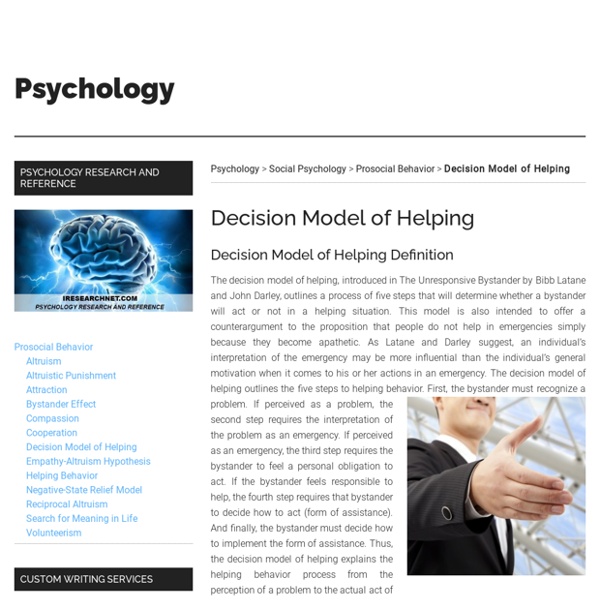Strategies for Effective Helping
In addition to the 5 Decision Making Steps, there are a number of strategies you can use for effective helping. (For action steps in each topic area please go to that specific topic): Emergency Helping — General Strategies Emergency situations unfold quickly and often require immediate helping responses.
How to Break the Bystander Effect
They could have left it to someone else. An Army veteran blocked a shooter in Oregon from entering his classroom. Three friends on a high-speed train from Paris to Amsterdam helped stop a gunman wielding an AK-47. This past spring, an Army captain in North Carolina pulled a couple to safety after a fiery car crash.
Six Ways to Boost Your “Habits of Helping”
In 2008, I lost my job of 20 years and uprooted my family to pursue a new position. The move strained my marriage, my relationship with my son, my sense of well-being. Like many Americans in their 50s who thought they were more or less past any financial worries, I found myself anxious for the first time in years. I know my story is not unusual. These are hard times.
How to Overcome the Bystander Effect
Psychologists have long been interested in exactly why and when we help other people. There has also been a tremendous amount of interest in the reasons why we sometimes don't help others. The bystander effect is a social phenomenon that occurs when people fail to help those in need due to the presence of other people. In many cases, people feel that since there are other people around, surely someone else will leap into action.1
Khaseen Morris (2019)
Image copyright Nassau County Police A New York teenager has been charged with the fatal stabbing of a 16-year-old boy whom bystanders filmed bleeding to death. Tyler Flach, 18, is accused of second-degree murder in the deadly after-school brawl that broke out not far from the victim's Long Island school.
What Is the Bystander Effect?
If you witnessed an emergency happening right before your eyes, you would certainly take some sort of action to help the person in trouble, right? While we might all like to believe that this is true, psychologists suggest that whether or not you intervene might depend upon the number of other witnesses present. What Is the Bystander Effect?
Jane Doe of Richmond High (2009)
MARTINEZ — Nearly four years after a gang rape at Richmond High School stunned the community and drew nationwide outrage, the victim of the brutal attack took the witness stand for the first time to recount her memories before she awoke the next day in “excruciating pain” in a trauma center. Jane Doe, who was a 16-year-old sophomore at the time of the attack, testified Monday she did not remember being sexually assaulted by a group of boys and men in a dark courtyard outside the school’s homecoming dance. But she recalled vividly the painful aftermath in the hospital. “My head really hurt, and I saw five of everybody staring at me,” said Doe, whose identity is being protected. “I felt very nauseous, as if someone had taken out my insides and stabbed them and put them back in.” Testifying at the trial of two of the men accused of taking part in the assault, the slight woman appeared nervous as she walked in the courtroom with stiff arms.
Beyond self-serving bias: diffusion of responsibility reduces sense of agency and outcome monitoring
We use cookies to enhance your experience on our website.By continuing to use our website, you are agreeing to our use of cookies. You can change your cookie settings at any time. <a href=" Find out more</a> Skip to Main Content Search
Larry Froistad (1998)
October 9, 1998 By THE ASOOCIATED PRESS ICKINSON, N.D. -- A man who confessed on the Internet to killing his daughter by setting their house on fire was sentenced to 40 years in prison Thursday by a judge who said the man broke the "most basic law of nature." "Living creatures ... protect their young," Judge Maurice Hunke of Southwest District Court told the man, Larry Froistad Jr. "You chose to cause the death of the most vulnerable victim there could be -- a child, your child."
How Diffusion of Responsibility Affects Group Behavior
Diffusion of responsibility is a psychological phenomenon in which people are less likely to take action when in the presence of a large group of people.1 For example, imagine that you are in a large city on a bustling street. You notice a man fall to the ground and start convulsing as if having a seizure. Many people turn and look at the man, but no one moves to help or call for medical assistance. Why?
How To Counteract The Bystander Effect - University of Pittsburgh Student EMS
Counteracting The Bystander Effect It is a beautiful spring day in Oakland. There are just a few weeks left until summer break and everyone is ready to go home.



